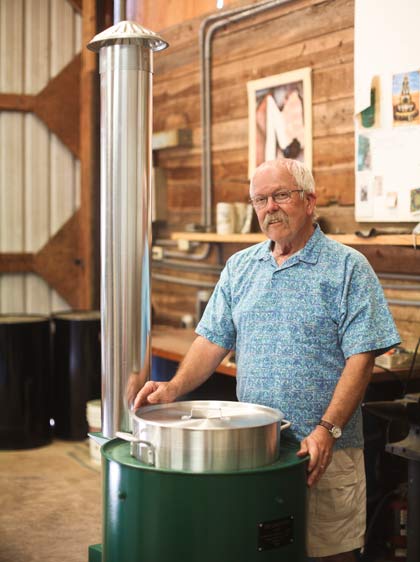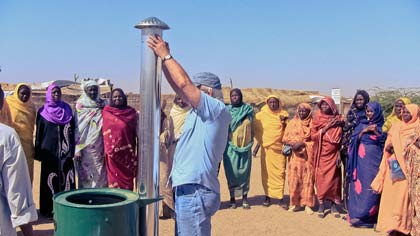On Colgan’s Island there are roses and a vegetable garden to attend to. There’s music blaring from a stereo in a workshop barn. There’s a gang of chickens and a tail-wagging black Labrador. There’s a former slaughterhouse and there’s a bright blue cottage. At the moment, this equally peaceful and industrious setting is the scene of many ongoing changes, and they all have to do with stoves.
The four-acre lot is tucked between a rusted railroad trestle and the Coast Fork Willamette River just north of Cottage Grove on Highway 99, and it has been the home of Aprovecho Research Center (ARC) since 2004. Fred Colgan has been warmly calling it his “island” since he moved here from California to retire with his wife. He spent years as a building contractor, but he also invested his time as a community organizer with a passion for social justice. Instead of retiring to fish and golf, he was excited that a nonprofit organization was going to build and test cooking stoves on his property after mutual acquaintances put them in touch. Colgan will now be the director of a split-off organization: Institutional Stove Solutions (InStove).
ARC is part of the Willamette Valley-based nonprofit known simply as Aprovecho (meaning to use, utilize and embrace in Spanish), which specializes in developing sustainable agricultural practices. For 29 years, an enclosed green stove with an aluminum chimney has been the center’s weapon of choice for combating pollution and health problems commonly attributed to use of open-fire cooking stoves in the developing world. Designed by ARC engineer Larry Winiarski, its cylindrical shape and internal combustion make its “rocket-stove” designation more than apt. A 60-liter stainless steel pot fits snugly in the top, and the heat down below is insulated, making the shell cool to the touch. Wood is fed through a slot at the bottom. On July 1, manufacturing this stove became the objective of InStove.
Stoves for the world
 |
| Fred Colgan and an InStove stove. Photo by Todd Cooper. |
 |
| Students at Otash School in Darfur. Photo courtesy InStove. |
On a back wall of the main office, the shelves are filled with stoves from around the world — both of clay and of metal. Since its infancy, ARC has worked at testing stoves from around the world in an effort to make them more fuel-efficient. According to Colgan, separating testing from manufacturing is a reason for making InStove and ARC two different organizations in an effort to promote credibility and neutrality.
Colgan has a large gray mustache, a short and sturdy build and is friendlier than his gruff-sounding voice would lead you to believe. On a tour through the testing-center, he points out new innovations that will come to fruition with InStove. One of them is a stainless steel pot with a pressure gauge sprouting from the top. He places it inside the green stove shell. “It’s like a sophisticated pressure cooker,” he says. “It forces the steam through everything that’s in there.”
This type of sterilization pot is known in the medical world as an autoclave, which forces heat in the form of steam through enclosed items. There are trials under way to implement the sterilization of medical equipment and waste, and a system to purify water by using the stoves’ capability to generate heat from within at up to 2,000 degrees Fahrenheit.
Autoclaves are already used in hospitals in the developing world. Colgan believes Aprovecho/InStove stove’s autoclave capability will be utilized in areas where there is spotty electricity as a backup. He sees it being used predominantly in rural clinics that have little or no access to electrical outlets. “This is a really inexpensive, super-efficient way to bring medical-grade sterilization to hospitals and clinics,” he says.
If sterilization of equipment is an issue that needs rectifying in the developing world, then so is medical waste. InStove expects the stove’s autoclave to be used in the same capacity before disposing of bloody bandages, culture dishes, latex gloves and, of course, needles, since HIV is prevalent in many developing countries. “Stuff coming out of hospitals isn’t being properly treated,” Colgan says of medical waste. “It goes into the waste stream.” He says that if the waste is burned in the open, it can release chemicals such as dioxin. According to the World Health Organization, exposure to such chemical compounds is “highly toxic and can cause reproductive and developmental problems, damage the immune system, interfere with hormones and also cause cancer.” The stove’s autoclave would apply hot steam to the waste in order to thoroughly sterilize it. “If they run it through an autoclave first it’s completely sterile,” Colgan says, “then it doesn’t matter how they dispose of it.”
By next spring, he also expects the organization to implement a water purification system that makes polluted water drinkable by way of the stove’s similarly applied high heat. Colgan’s partner in the project and engineer, Damon Ogle, is producing a liter of clean drinking water every 15 seconds in trials with the current stove. “This system kills every critter that harms human health,” Colgan says.
Stove production
Across from the former slaughterhouse turned testing center, Dennis Hartley, a volunteer in the office for more than a year, walks through the workshop with its blaring music for the builders who are hammering and welding away. Against the wall are stacks of the slender steel barrels that will become stoves.
The shop currently puts together 10 stoves a day. Right now, Colgan says that United Nations agencies are their biggest customer, putting the stoves to use at refugee camps. During this period of transition, Hartley says 200 stoves are currently being used in Darfur and 60 are being used in Ethiopia. But soon this will change too. The number of stoves being used overseas is expected to increase as InStove transitions.
Within ARC, Colgan and Ogle developed the Institutional Stove Project, which saw a need for more stoves around the developing world at schools and other institutions. “Our goal is to see as many of these [stoves] mass produced as possible because the need is so huge,” Colgan says. He recalls a school in Nigeria where three stoves have been used to feed 1,200 students every day. “People are just clamoring for these stoves,” he says. The new organization has plans to open a factory by the fall of 2012 in Nigeria, and they have initiatives floating for factories in Kenya, Uganda and Ghana. The organization’s motives for in-country production are two-fold: It will employ local people, and the stoves can be more easily repaired by in-country employees. He estimates that because the parts of the stove are so interchangeable, the stoves can last up to 10 years if there is a local shop to repair them on the ground.
InStove will also be expanding its production of the green stoves in the Willamette Valley. The organization has been scouting out real estate with more space to operate out of in Cottage Grove. On the island, when the stoves are ready to be shipped overseas, the workers have taken the stoves in a U-Haul across Highway 99 to a lumberyard before putting them on a larger delivery truck because the larger truck wouldn’t fit underneath the railroad trestle. Colgan expects the staff of three builders to increase to 10 full-time employees in the next 12 months and double that in the next 18. “This is going to grow very fast,” he says.
Because of the need to feed large numbers of people, the new organization will also be building a 100-liter version of the stove. The wider and taller adaptation will actually produce a greater benefit. “It’s a happy accident of physics,” Colgan says about the larger version. He describes how because it is bigger there is more heat transfer. “The bigger the pot the more area that’s basically attracting the heat — we get better heat transfer.”
Another addition InStove plans to implement will be addressing wood scarcity, which can be a cause for contention between people in African countries and other parts of the developing world. “There’s no trees left there, no fuel left,” Colgan says about places like Darfur and Haiti.
The nonprofit has developed a prototype mechanism that looks not unlike a medieval torture device, which forms a mold of waste paper, animal dung, straw, crop waste, pretty much “anything they can find,” he says. The slurry forms into what InStove is calling biomass briquettes, which are put in the sun to dry. According to Colgan, this will ultimately replace 80 percent of the need for wood for the stoves. “It burns in our stoves the same fuel value as wood,” he says. This technique is still being tested out and will be used in field trials overseas later this year.
Youth involvement
Along with new use of Aprovecho’s original stove and expanding production, InStove is making an effort to get the younger generation involved with its growing organization. Hartley says the goal is to recruit “young people with energy.” He adds, “We’re reaching out in a lot of different directions to create an organization with a support system.”
One of those ways is to tap into the availability of passionate students from the nearby UO. Vesta Tsao, who will be a senior at the UO next fall, began interning at the organization after hearing about it at the school’s local undergrad chapter of Net Impact, a national student organization that has students put their business skills to use by finding more sustainable business practices. When Tsao came to InStove, she found it unique and different from other internships. “What they really want is to get more young people involved,” she says. “They kind of let you do your own thing.” Tsao was able to be creative in finding ways to brainstorm partnership ideas with local businesses and seek out the Cottage Grove community. Along with Stella Strother-Blood, a recent graduate of Western Oregon University who is working for InStove, Tsao will be doing outreach to connect UO students with the organization in the hopes of cultivating volunteers. A UO student advocacy group is in the works, according to Hartley, and Tsao foresees the possibility of an office on campus where students can come in and obtain information about the organization. Volunteers, donors, organizational people — all kinds will be needed to help move the organization forward and younger innovators are what ISS is aiming to attract at the moment.
All the change and excitement has Colgan traveling a lot these days — during the first week of July he traveled to Geneva, Switzerland, to meet with U.N. agencies and other potential stove purchasers. He has his phone constantly by his side and admits he has a lot of balls in the air right now. But the mission of Aprovecho’s stoves and now InStove is still very simple. “From the very beginning we set out to help the poorest of the poor,” he says. “Our mission is to help poor people and now to create a sustainable organization.” Although it might be scary to see so much change in a short amount of time, he still has a smile behind his mustache, saying “it’s really fun to be a part of something that brings change to people’s lives.”
See www.instove.org for more information.
Stoves with a purpose
StoveTeam International, a Eugene-based organization that is closely tied to nearby Aprovecho Research Center almost didn’t get off the ground. After Nancy Hughes’ husband passed away in 2001, she began volunteering in Guatemala as a cook with Cascade Medical Team. She saw what smoke from open-fire cooking was doing to women and children. She was overwhelmed by the incredible need for safe stoves that wouldn’t send smoke directly into the lungs of cooks and their children and put them at risk of burns.
In 2007 Larry Winiarski showed her his design for what would become the Ecocina stove. The clay stove is shorter and stouter than the Aprovecho “rocket-stove” that Winiarksi also designed, but it serves the same function.
To get started, Hughes got a little help from a legendary guitarist: Carlos Santana. His Milagro Foundation made a donation of $10,000 to get a factory started in El Salvador producing the Ecocina stove, which is a hybrid of the English prefix for environmental and the Spanish word for kitchen.
StoveTeam International has had the Ecocina stove tested at Aprovecho. They found out that it cuts down on about 50 percent of wood usage. It is easy to start and is also cool to the touch. The organization now has six factories in five countries, all created within the last four years.
The stoves are being manufactured mainly in Central America with local workers manufacturing them in El Salvador, Guatemala, Honduras and now Mexico.
In December 2011, Nancy Hughes made her way to San Francisco Bay to officially receive a Purpose Prize, which entailed $100,000 for her work.
The prize was awarded to five other Americans over 60 who are making a difference. “I told my kids I’m now certifiably old,” Hughes, now 69, says with a laugh. Her colleague nominated her for the prize after hearing about it on NPR. “I didn’t know anything about it,” she says.
The large sum of money from the prize is being put to good use. “It went all to StoveTeam,” Hughes says. “That’s why I got the prize.”
